xMEMS Announces World's First Monolithic MEMS Speaker
by Andrei Frumusanu on July 7, 2020 9:00 AM EST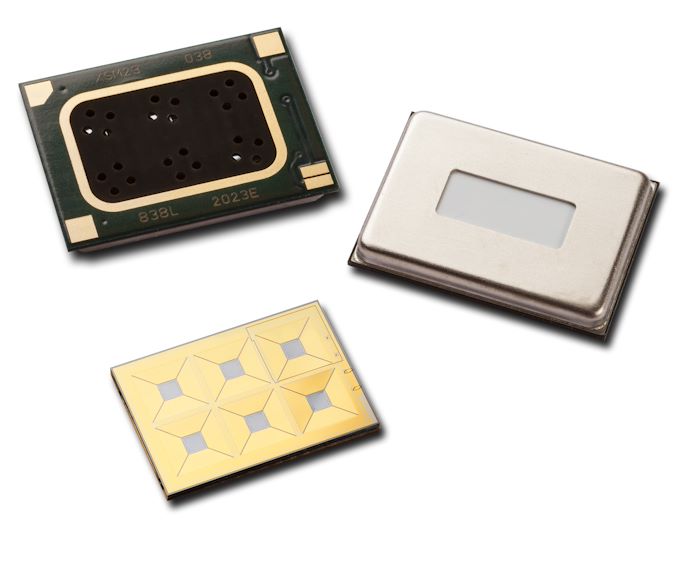
Speakers aren’t traditionally part of our coverage, but today’s announcement of xMEMS’ new speaker technology is something that everybody should take note of. Voice coil speakers as we know them and have been around in one form or another for over a hundred years and have been the basis of how we experience audio playback.
In the last few years, semiconductor manufacturing has become more prevalent and accessible, with MEMS (Microelectromechanical systems) technology now having advanced to a point that we can design speakers with characteristics that are fundamentally different from traditional dynamic drivers or balanced armature units. xMEMS’ “Montara” design promises to be precisely such an alternative.
xMEMS is a new start-up, founded in 2017 with headquarters in Santa Clara, CA and with a branch office in Taiwan. To date the company had been in stealth mode, not having publicly released any product till today. The company’s motivations are said to be breaking decades old speaker technology barriers and reinventing sound with new innovative pure silicon solutions, using extensive experience that its founders have collected over years at different MEMS design houses.
The manufacturing of xMEMS’ pure silicon speaker is very different to that of a conventional speaker. As the speaker is essentially just one monolithic piece manufactured via your typical lithography manufacturing process, much like how other silicon chips are designed. Due to this monolithic design aspect, the manufacturing line has significantly less complexity versus voice coil designs which have a plethora of components that need to be precision assembled – a task that is quoted to require thousands of factory workers.
The company didn’t want to disclose the actual process node of the design, but expect something quite crude in the micron range – they only confirmed that it was a 200mm wafer technology.
Besides the simplification of the manufacturing line, another big advantage of the lithographic aspect of a MEMS speaker is the fact that its manufacturing precision and repeatability are significantly superior to that of a more variable voice coil design. The mechanical aspects of the design also has key advantages, for example higher consistency membrane movement which allows higher responsiveness and lower THD for active noise cancellation.
xMEMS’ Montara design comes in an 8.4 x 6.06 mm silicon die (50.9mm²) with 6 so-called speaker “cells” – the individual speaker MEMS elements that are repeated across the chip. The speaker’s frequency response covers the full range from 10Hz to up to 20KHz, something which current dynamic driver or balanced armature drivers have issues with, and why we see multiple such speakers being employed for covering different parts of the frequency range.
The design is said to have extremely good distortion characteristics, able to compete with planar magnetic designs and promises to have only 0.5% THD at 200Hz – 20KHz.
As these speakers are capacitive piezo-driven versus current driven, they are able to cut power consumption to fractions of that of a typical voice coil driver, only using up 42µW of power.
Size is also a key advantage of the new technology. Currently xMEMS is producing a standard package solution with the sound coming perpendicularly out of the package which has the aforementioned 8.4 x 6.05 x 0.985mm footprint, but we’ll also see a side-firing solution which has the same dimensions, however allows manufacturers to better manage internal earphone design and component positioning.
In the above crude 3D printed unit with no optimisations whatsoever in terms of sound design, xMEMS easily managed to design an earphone of similar dimensions to that of current standard designs. In fact, commercial products are likely to looks much better and to better take advantage of the size and volume savings that such a design would allow.
One key aspect of the capacitive piezo-drive is that it requires a different amplifier design to that of classical speaker. Montara can be driven up to 30V peak-to-peak signals which is well above the range of your existing amplifier designs. As such, customers wishing to deploy a MEMS speaker design such as the Montara requires an additional companion chip, such as Texas Instruments’ LM48580.
In my view this is one of the big hurdles for more widespread adoption of the technology as it will limit its usage to more integrated solutions which do actually offer the proper amplifier design to drive the speakers – a lot of existing audio solutions out there will need an extra adapter/amp if any vendor actually decides to actually make a non-integrated “dumb” earphone design (As in, your classical 3.5mm ear/headphones).
TWS (True wireless stereo) headphones here obviously are the prime target market for the Montara as the amplifier aspect can be addressed at design, and such products can fully take advantage of the size, weight and power advantages of the new speaker technology.
In measurements, using the crude 3D-printed earphone prototype depicted earlier, xMEMS showcases that the Montara MEMS speaker has significantly higher SPL than any other earphone solution, with production models fully achieving the targeted 115dB SPL (The prototype only had 5 of the 6 cells active). The native frequency response here is much higher in the higher frequencies – allowing vendors headroom in order adapt and filter the sound signature in their designs. Filtering down is much easier than boosting at these frequencies.
THD at 94dB SPL is also significantly better than even an unnamed pair of $900 professional IEMs – and again, there’s emphasis that this is just a crude design with no audio optimisations whatsoever.
In terms of cost, xMEMS didn’t disclose any precise figure, but shared with us that it’ll be in the range of current balanced armature designs. xMEMS’ Montara speaker is now sampling to vendors, with expected mass production kicking in around spring next year – with commercial devices from vendors also likely to see the light of day around this time.


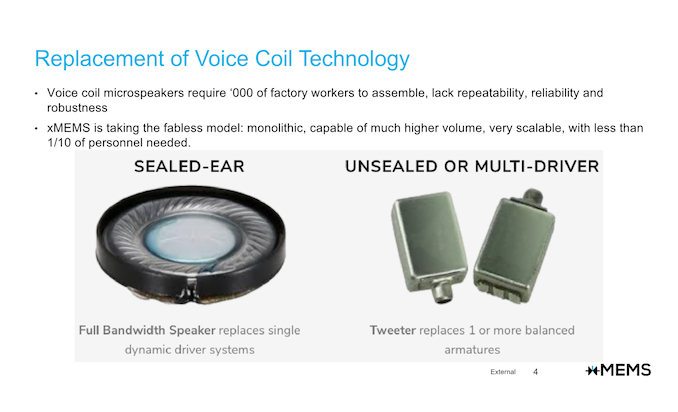
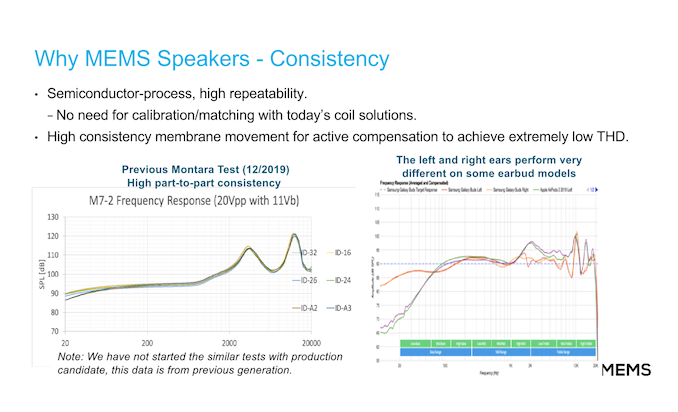
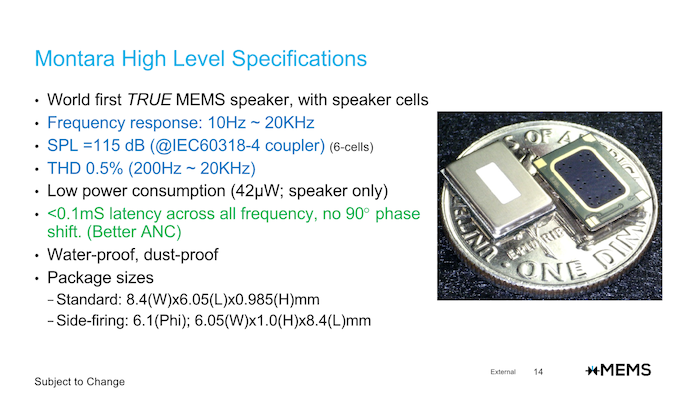
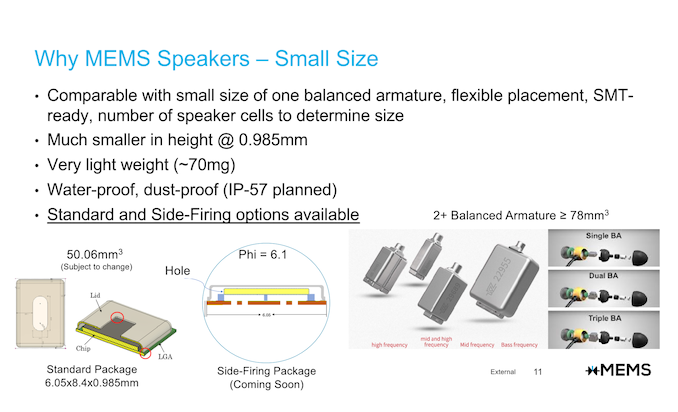

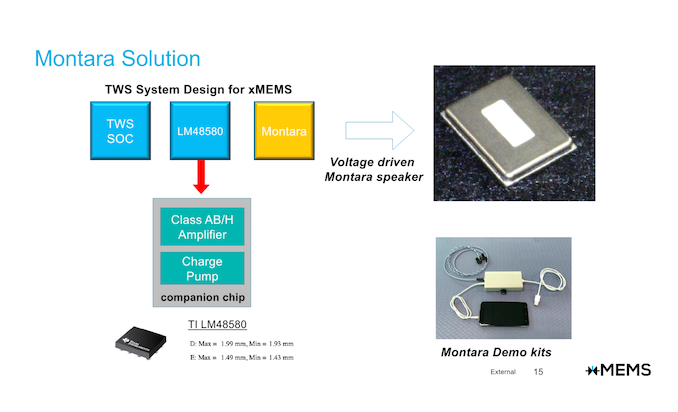
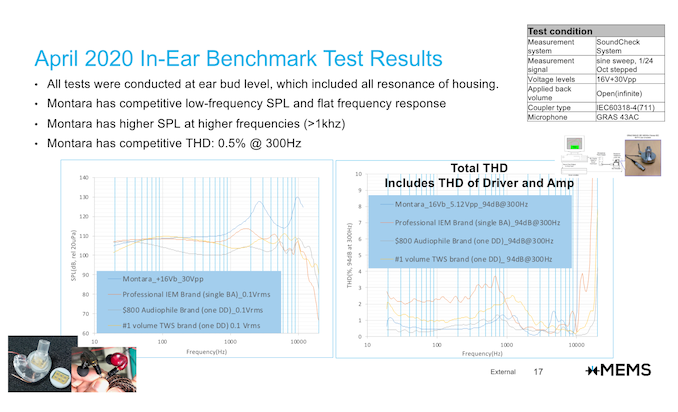
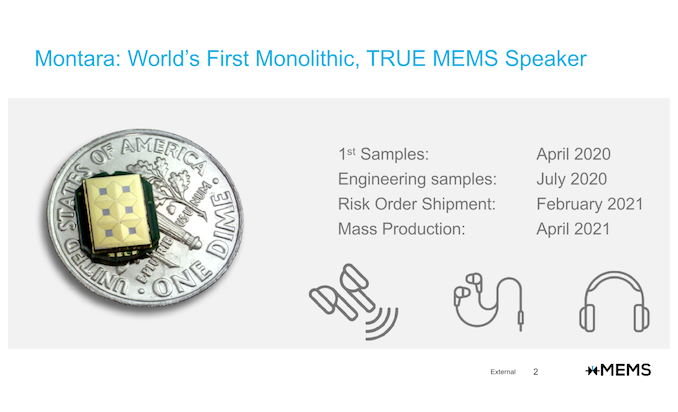








58 Comments
View All Comments
s.yu - Thursday, July 9, 2020 - link
Ugh, no. Get a pair of CIEMs and be done with ANC. I use mine unplugged in the shooting range, to better effect than the thick heavy earmuffs provided there.willis936 - Thursday, July 9, 2020 - link
Why not both?s.yu - Saturday, July 11, 2020 - link
Currently unfeasible? There are no ANC CIEMs AFAIK and further making that wireless in his argument complicates that even further.psychobriggsy - Tuesday, July 7, 2020 - link
I await the wafer-scale MEMS speaker/driver technology for floorstanding speakers.mode_13h - Tuesday, July 7, 2020 - link
You'd probably do fine with multiple discrete chips that aren't all on the same wafer, which would save you from needing to have an essentially perfect wafer. Plus, you could use fewer chips, at quite a cost savings.brucethemoose - Tuesday, July 7, 2020 - link
Amazing tech! This is definitely in Anandtech's realm.Many audiophiles balk at the idea of internal amps, but pairing a amp specifically for the load its driving is advantageous in many ways. Thats doubly true for the DAC, which can run a DSP to flatten the frequency response of that specific system.
I'd be interested to see a design with one of these paired with a Class D DAC, maybe with a dynamic driver to help with low end frequency response.
mode_13h - Tuesday, July 7, 2020 - link
I like the way you're thinking!Class D seems like it *could* be nearly the perfect solution for internally-amplified speakers, if developed enough. Not sure how common it really is, though. I thought Class D would take off more than it seems like it has (last I checked).
brucethemoose - Wednesday, July 8, 2020 - link
Its definitely taking off. What really sold me on class D was a bookshelf speaker set that use an integrated class D DAC/amp, and that was a few years ago.edzieba - Thursday, July 9, 2020 - link
Any design incorporating both drivers and an amplifier (and DSP, because silicon is cheap) has no excuse for not producing a perfect flat response from every available input, limited only be the lowest peak output level across the useful frequency range.Any distortions from a flat response (e.g. the oft-desirable 'tube amp sound' can be perfectly replicated via DSP by characterising and replicating the transfer function of that system.
pashhtk27 - Wednesday, July 15, 2020 - link
Yes, I wholeheartedly agree. This is revolutionary if it works as well as it is claimed. Current TWS and wireless IEMs are plagued with poor driver selection and congested acoustic chambers, and this could help alleviate that and really help bridge the gap between wired and wireless.I personally prefer IEMs over speakers and full sized headphones as for me they are more comfortable, convenient, less fragile, and easily driven. I personally also like the sound characteristics and isolation offered by most IEMs (even if that may be 'unnatural'). Modern low power hybrid chips like the ES9218 are objectively fantastic for low impedance IEMs, and as you have said comparable chips could be tailor made for the earphone.
These are interesting times for audio lovers.